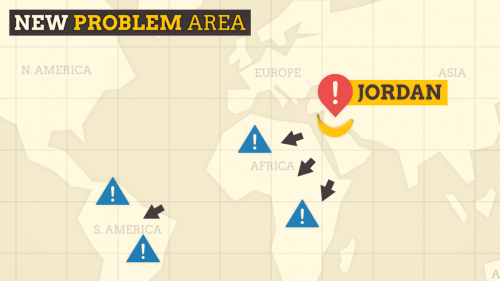Panama disease on the move. Jordan: new problem area.
Panama disease is causing significant damage in banana cultivation in Southeast Asia. Together with a number of partners, scientists from Wageningen UR (University & Research centre) have demonstrated that the disease – caused by the fungus Fusarium oxysporum f. sp. cubense – has now also migrated to Jordan. This means that Panama disease is becoming increasingly widespread and major banana-producing countries in Africa and Latin America are also under threat. A concerted international approach is needed to safeguard the food security of millions of people. The results of the study were published in the scientific journal Plant Disease.
The banana is not just the world's favourite fruit – for many people it is a vital important source of food. During the twentieth century, tens of thousands of hectares of banana plantations in Latin America were destroyed by Panama disease. Banana plants died en masse and soils are contaminated for decades. The introduction of the resistant Cavendish banana variety saved the day and clones of the Cavendish banana are now cultivated worldwide. Late last century, however, a new, highly aggressive strain of the fungus was discovered in Southeast Asia. Tropical Race 4 (TR4) is starting to have a huge effect on the Cavendish cultivar in Southeast Asia and there is currently no way to protect the banana.
There were suspicions a few years ago that some banana plantations in Jordan were infected with Panama disease. The Jordanian Ministry of Agriculture later sent samples of the fungus to Professor Randy Ploetz of the University of Florida, who forwarded them to Gert Kema, a scientist at Wageningen UR. PhD students from Gert Kema's research group infected different banana plants with the fungus from the Jordan samples. These plants developed the same symptoms as banana plants infected with samples from Southeast Asia. Subsequent DNA tests showed that the Jordan strains were identical to TR4. The scientists have thereby established that TR4 has now spread beyond Southeast Asia.
Relatively few bananas are grown in Jordan – bananas are cultivated on around 1000-1500 hectares – but 80% of the plantations are now infected. It is unclear how Panama disease spread from Southeast Asia. Gert Kema argues that it is only a question of time before TR4 reaches Africa. In Africa, bananas are an important part of people's diet, and the introduction and spread of Panama disease would threaten the food security of millions. "A concerted international approach is now needed to prevent the spread of Panama disease and, in the worst-case scenario, contain it," Kema states.
Provided by Wageningen University





















